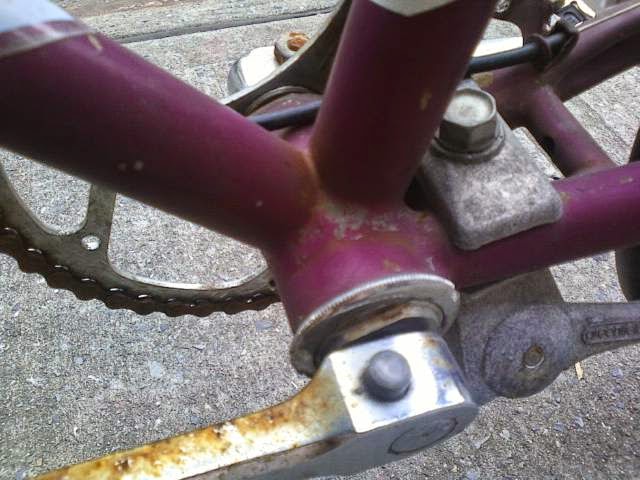For a moment, I thought someone tried to ride a handcuff.

Turns out, the contraption is even cleverer (Now there's a word only a Brit can get away with using!) than that.
That strange-looking rear wheel is belt-driven and hubless. (Could even a Brit get away with saying "hubless"?) The moving parts are housed, which makes the bike's wheelbase.
Luke Douglas, the wheel's creator, said he was trying to make a bike as compact as possible without having to fold it. He said he was also trying to eliminate the awkward ride qualities of many folding or collapsible bikes.
At the time he designed it, he was a student at the Loughborough (UK) Design School. He entered it in the 2011 competition for the James Dyson Award. Alas, he didn't win.
He should have gotten some kind of award, though, for the name he gave his invention: the Lunartic.
I admit this photo hasn't much to do with cycling, save for the fact that I took it on Point Lookout, one of the places to which I pedaled last week.
But somehow it seems right for a Sunday afternoon in summer. And I suppose it has something like composition and a balance of tones in it. Even if it doesn't, I hope you like it.
Having
your bike stolen is never a happy experience. Even if it's an old
rust-holder or is ridden only occasionally, losing your bike means
losing a part of yourself, however small.
The
reason, I believe,is that any bike we own holds some part of our
experience. Of course, if it's a bike you ride every day, whether to
work or for pleasure, it's a companion. If you took a
once-in-a-lifetime tour, or raced, on it, it was an extension of you.
And, even if your relationship with your steed isn't so intimate, you
have a memory of acquiring it.
If the bike was previously ridden by someone dear to you, of course that makes it all the more precious. Just ask Mikaela Rogers.
Three
decades earlier, a teenaged Mike Rogers got tired of riding
pieced-together hand-me-downs and saved the wages of his minimum-wage
job for a black Bianchi Sport SS. He rode it to school, on a tour and
the bike paths that were later built in Minneapolis, near his home
turf. But one day he noticed that riding left him even more fatigued
and in pain than usual. He thought he was just out of shape and that he
could pedal his way back to health. If only...
He died three years ago from Amyotrophic Lateral Sclerosis, also known as Lou Gherig's disease.
After
he could no longer mount the Bianchi, Mikaela--who was, by that time,
almost the same age Mike was when he bought it--rode to and from school
and around town much as he did three decades earlier, even though the
frame was much too big for her. She simply wouldn't dream of riding
anything else.
So,
of course, one of her most heartbreaking experiences--short of losing
her father--was going to the family's shed and not seeing the bike
hanging from its usual perch.
Fortunately,
this story has a happy ending. Someone found the bike abandoned on a
street corner, placed an ad in Craigslist and reunited the Bianchi--and
the memories of the man who bought it so many years earlier--with a
young woman.
Yesterday I saw this bike parked on Greenpoint Avenue:
Of course, I loved the color and was fascinated with the way the twin-lateral tubes curved from the seat tube to the rear dropout. It's not the first time I've seen such a configuration. Still, something told me there was something strange about the bike.
The Huret Allvit derailleur on the rear was more than likely original equipment. To paraphrase Frank Berto, it shifts poorly forever. The crankset also looked as if it had never been removed from the bike, although I suspect that, at some point, a chainguard was.
The shift lever was a plastic model from Simplex. Perhaps the derailleur was a replacement after all. Or maybe the shifter was. It was interesting, though, to see it on a brazed-on boss. But what I saw in front of it:
Or at the bottom bracket:
Perhaps
my initial belief that this bike was French was wrong after all. Almost
any Gallic ladies' or mixte bike of the era from which this bike appeared to be
(the early 1970's or earlier) that wasn't made by a constructeur had
lugs. Perhaps I was looking at a cleverly-disguised masterpiece.
Not
surprisingly, the wheels and pedals were replacements. So, too, was the rear
brake, I suspect:
Nearly
all modern caliper brakes are mounted in a hole through the front fork crown or
a bridge connecting the rear stays. At one time, calipers that clamped like the
one in the photo were common. Later, they were used on bikes that
originally were equipped with cantilever or rod brakes, which usually weren't
drilled. But no one, it seems, made such brakes after the mid-1960's or
thereabouts.
Stickers from Transportation Alternatives and other cycling-related organizations indicate that this bike is, or had been, ridden regularly. I wonder whether its rider has or had any idea of what he or she is or was riding.
Airlines are always trying to stuff as many passengers as possible into every flight.
So it shouldn't come as any surprise that they want to find ways to cram more seats into every plane. Barring any sudden changes in human evolutions or American diets, seats can be shrunk only so much before no one can sit in them.
Back in December, European aircraft maker Airbus filed a patent for a new kind of seat:
A bicycle seat on planes? Hmm. I wonder if there are options for the kind of bicycle seat--racing, touring, cruiser, "Bummer" or whatever--a passenger might like.
An even better idea might be to install pods that can take bicycle seats of the passengers' choice, including the passengers' own. I mean, if I want to ride my Brooks B17 or someone else wants to spend a flight perched on an '80's Concor, Ideale 90 Speciale Competition, Terry Butterfly or Dimension Noseless saddle, why shouldn't we have that choice?
Of course, if the airlines did that, they'd find an excuse to charge even higher fares. Or they actually implement an idea Ryanair had a few years ago.
A man riding his bicycle strikes a barbed-wire fence and flipped over his handlebars.
Ouch!
According to police officers who pursued him, he continued his flight on foot.
I'm having a very difficult time imagining how the man managed not to entangle himself in the barbed wire if he flipped over his bars when he crashed into the fence.
And I'm having only a slightly less difficult time envisioning someone who took such a tumble--whether or not he was impaled with the barbed wire--getting up and running away.
Maybe I'm just a wimp with a low pain threshold. Or, maybe the man's ability to endure suffering is explained by what the cops found beside his bike: a box of prescription pills. After they used a TASER on him, they also found a marijuana pipe in his pocket and a small amount of marijuana in an undisclosed location.
 He's quite the character: A warrants check showed that he was wanted for possession of a controlled substance, injury to a child and bond forfeiture related to his failure to comply with a sex-offender registration law.
Hmm...Maybe the pot and pills weren't the only reason why he got up and ran after crashing the bicycle into a barbed wire fence and flipping over the bars.
From what I see in the photo, the bike doesn't look any the worse for the experience.
He's quite the character: A warrants check showed that he was wanted for possession of a controlled substance, injury to a child and bond forfeiture related to his failure to comply with a sex-offender registration law.
Hmm...Maybe the pot and pills weren't the only reason why he got up and ran after crashing the bicycle into a barbed wire fence and flipping over the bars.
From what I see in the photo, the bike doesn't look any the worse for the experience.









